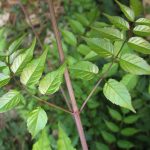 A leaf with two or more distinct leaflets.
A leaf with two or more distinct leaflets.
Two or more leaflets attached to the leaf stalk (e.g., Walnut, Horse Chestnut, or Lupine).
A leaf divided into two or more units, with each unit, or leaflet, resembling a separate leaf.
Having the blade divided to the midrib and forming two or more leaflets on a common axis.
Leaf with more than one blade (leaflet) connected to a common stalk.
A leaf with a blade that is divided into several, smaller leaflets.
A leaf divided into separate leaflets, without any flange joining them together along their common stalk (cf pinnate and palmate).
Subdivided into several leaflets, as in a rose or palm leaf. Leaves not so subdivided are called “simple.”
A leaf that is divided into two or more leaflets, each of which may look like a complete leaf but which lacks buds. Compound leaves may have leaflets arranged along an axis like the rays of a feather or radiating from a common point like the fingers on a hand.
